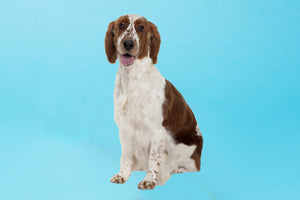
FREE UK DELIVERY ON ORDERS OVER £39.99

Who doesn’t love to see a black and white spotty Dalmatian running around their local dog park? While the popular Walt Disney movie may have featured a whopping 101 Dalmatians, sadly we don’t see as many as we would like to here in the UK.
This breed may be rare because there are quite a few health conditions from which they suffer. They are also a very active breed and not every family is set up to meet their needs.
Did you know that the Dalmatian was a ‘carriage’ dog who would run alongside coaches and carriages to protect the occupiers from being harassed or mugged by passers-by? Interestingly, the wealthiest people would have the most Dalmatians and some would have up to eight dogs running along beside them.
As well as being famous as ‘coach dogs’, Dalmatians are synonymous with the fire service. They were once used to run alongside the horse-drawn fire brigades and they are now a mascot of many fire stations worldwide.
The first thing you will notice about the Dalmatian is its unique spotty coat. Puppies are born white and then develop pigmented spots as they get a little older. While most develop black spots, it is possible for Dalmatians to have brown, grey or orange spots too.
Dalmatians can be a large dog and the male can grow to 61cm when measured at the withers. They are muscular and stocky and may reach weights of up to 32kg when fully grown.
They have a long and wide muzzle and their ears fold down. Their neck is long and thick while they have a deep chest and long, lean limbs. Their tail is skinny and tapers to the tip, reaching the hock.
Given their history as coach dogs, it is little wonder that some Dalmatians remain protective to this day. They have a tendency to guard their territory and can be possessive over their owners and their home. This works well for some people but others will dislike this attribute of theirs. It is important that all Dalmatians are thoroughly socialised from a young age to avoid aggression.
Most Dalmatians are energetic and sociable, eager to be part of whatever is going on, both inside and outside of the home. Though they can get along well with children, they can be rambunctious and don’t always consider that young children aren’t as sturdy as them!
As is the case with a number of purebred dogs, Dalmatians suffer from a range of inherited health issues. These include:
Under the right direction, Dalmatians can be highly trained. However, no dog is ‘easy’ to train and they require someone who is dedicated to their progression and development. They respond best to positive reward-based training and (like all of us!) like to be praised when they do well. Consider training treats such as Pooch & Mutt’s Meaty Treats to help keep them on side during training sessions. Remember, even adults need daily training and it isn’t an activity reserved for puppies.
The short coat of the Dalmatian is relatively easy to care for. Despite this, they do shed considerably, especially in the warmer months. Owners should introduce tooth brushing from a young age and aim to brush their Dalmatian’s teeth at least three times a week.
Given their history, we should expect our Dalmatians to be very active individuals that are best suited to those who like to keep fit. They love running long distances and make excellent jogging and cycling companions.
Care is advised when Dalmatians are young and their joints are still developing as they are prone to damage if over-exercised. Stick to softer surfaces such as grass and sand rather than pavement or roads.
Growing Dalmatians require plenty of high-quality protein and omega fatty acids and it is worth considering offering them a food such as the Pooch & Mutt Puppy Superfood as it supports growing bodies and contains salmon oil for cognitive development.
You'll find a handy feeding calculator on every product page here at Pooch & Mutt to help you identify how much of our health led recipes are right for the age, size and weight of your dog.
Comments (1)
The P&M Puppy Superfood mentioned above is not suitable for Dalmatians on a low purine diet due to inclusion of brewers yeast which is very high in purines. Can you change the article text or recommend a different food that is more suitable so as not to mislead readers?
Leave a comment